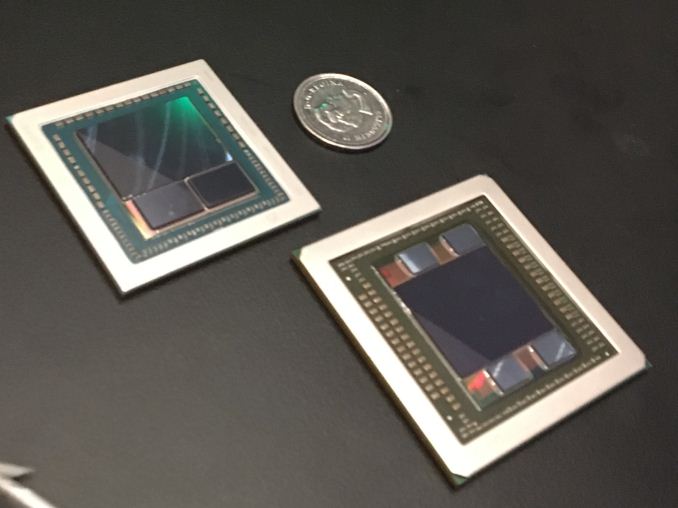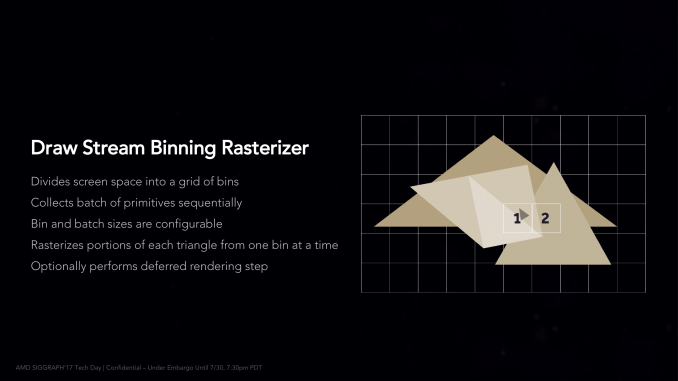Radeon RX Vega Unveiled: AMD Announces $499 RX Vega 64 & $399 RX Vega 56, Launching August 14th
by Ryan Smith on July 30, 2017 10:30 PM ESTFeatures & the Future Launch
Last but not least, along with today’s card announcements, AMD has also lifted the embargos on the architectural elements of the Vega 10 GPU. While there are no new architecture features to discuss – it turns out AMD was rather thorough with their preview at the start of this year – there’s still quite a bit in the way of details to dig into here. In fact it's more than I can hope to cover in a single day, let alone the few hours I’m getting to write this article ahead of AMD’s embargo. So I want to hit the highlights.
First and foremost, AMD has clarified that they do not consider Vega 10 to be a high performance computing (HPC) chip, unlike Hawaii. In particular, Vega 10’s native FP64 rate is just 1/16, like AMD’s other consumer chips. And the chip, while supporting HBM2’s native ECC mode, doesn’t have ECC on its internal pathways. This doesn’t mean that the chip can’t be placed in a server – its FP16 and INT16/INT8 performance is the cornerstone of its existence as part of the Radeon Instinct family. But that’s still a different market than traditional HPC. When we might see another HPC chip from AMD is anyone’s guess at this moment.
Second of all, we have a formal die size and transistor count for Vega 10. The GPU is officially 486mm2, containing 12.5B transistors therein. That amounts to 3.9B more transistors than Fiji – an especially apt comparison since Fiji is also a 64 CU/64 ROP card – all the while being 112mm2 smaller than Fiji (despite the higher transistor count) thanks to the higher density of GloFo’s 14nm LPP process, which AMD is using to fab the chip.
Talking to AMD’s engineers, what especially surprised me is where the bulk of those transistors went; the single largest consumer of the additional 3.9B transistors was spent on designing the chip to clock much higher than Fiji. Vega 10 can reach 1.7GHz, whereas Fiji couldn’t do much more than 1.05GHz. Additional transistors are needed to add pipeline stages at various points or build in latency hiding mechanisms, as electrons can only move so far on a single clock cycle; this is something we’ve seen in NVIDIA’s Pascal, not to mention countless CPU designs. Still, what it means is that those 3.9B transistors are serving a very important performance purpose: allowing AMD to clock the card high enough to see significant performance gains over Fiji.
Speaking of Fiji, there’s been some question over whether the already shipping Vega FE cards had AMD’s Draw Steam Binning Rasterizer enabled, which is one of the Vega architecture’s new features. The short answer is that no, the DSBR is not enabled in Vega FE’s current drivers. Whereas we have been told to expect it with the RX Vega launch. AMD is being careful not to make too many promises here – the performance and power impact of the DSBR vary wildly with the software used – but it means that the RX Vega will have a bit more going on than the Vega FE at launch.
Fifth, AMD is tweaking their boost clock mechanism and how it's advertised. Up until now, the boost clock was the maximum clock a Radeon card would hit. e.g. a stock Fury X topped out at 1.05GHz, and a stock RX 580 at 1340MHz. Starting with Vega RX, however, the company's definition of the boost clock is changing to the highest clockspeed a card is guaranteed to hit, but not the absolute highest clockspeed it can hit under load. There are still some nuances I want to test once I have the hardware in-hand, but at first glance this sounds closer to NVIDIA's definition, where each and every card is allowed to reach its natural limit (for the stock voltage).
Finally, while AMD didn’t clarify exactly when this change was made, the company has tweaked their Freesync Low Framerate Compensation technology to work with monitors that have a 2x range between min and max refresh rates, as opposed to 2.5x at launch. I’m told that 2.5x (or better) is still the ideal range, but it now works at 2x. This is an important development because the Samsung CF791 monitor that AMD is discounting as part of the Radeon Pack bundles has a 48Hz to 100Hz range; so it wouldn’t have been LFC capable under the old LFC rules.
Overall AMD has given us a lot to chew on – and more that can be covered in a single afternoon – but we still haven’t seen the whole picture. Today’s announcement of the card specifications and prices sets a very important baseline for what we should expect on August 14th, but no hard performance numbers to judge the final product. As I said at the start of this article, AMD’s marketing has done a very good job keeping Vega in the public’s mind. And today’s announcement is the next phase of that plan. But the end is approaching, and RX Vega’s full launch is drawing near, so it will be very interesting to see how everything we’ve learned over the last several months translates into gaming performance, power efficiency, and where AMD’s new place shall be in the realm of high-end video cards.













162 Comments
View All Comments
lordken - Monday, July 31, 2017 - link
exactly this! I was like wtf after reading that first lines, had to triple check if reading AT article...calling this marketing disaster,fiasco, failure something worth of giving praise is duh huh beyond ridiculousness.I think marketing did more damage to the card than poor engineering. Problem is they did hype it beyond craziness with stellar architecture stellar performance for something that's product between 1070-1080 for higher price, the hypetrain hit the rock wall, hard.
I'm pretty sure that most of fans and enthusiasts that did follow Vega since early beginning take this Vega for failure. So if PR fools wouldn't overhype the shit out of this card , and treat it like normal product, it could be taken as decent 1070/1080 alternative that came year later but still able to deliver some competition to NVidia...
So in this light personally I see it even worse than "overclocker's dream" Fury...
Not to mention all the ppl that pulled trigger on 1080/ti that couldn't wait anymore for idiots at AMD PR that delayed delayed and without any relevant information.
...and someone calls the marketing team competent...
Morawka - Sunday, July 30, 2017 - link
So TomsHardware is already confirming that VEGA 64 is slower than even a Vanilla GTX 1080, much less than a 1080Ti. It probably won't be far behind a gtx 1080, but they are trying to charge $600 for it, so i don't see them doing well with this card unless it mines like a republican in west virginiaEnlows1 - Monday, July 31, 2017 - link
no no no no it's 600$ for the bundle which gives you a 64 air cooled vega card a ryzen 7 cpu a curved samsung monitor that is 3440 * 1440 a mother board and 2 games now that is what you call a fucking steal m8nevcairiel - Monday, July 31, 2017 - link
Thats not what the bundles give you. They give you games, sure, but both AMD and NVIDIA do that all the time.The other things are just small discounts on those products, you don't get all that for $600.
HAILHOFF - Monday, July 31, 2017 - link
Nah you just get discounts on the other items, $100 off a CPU motherboard Combo and $200 off a $900 Moniter and two free games. Pretty mediocore if you ask me. I was patiently waiting for Vega but this is just ridiculous, It makes more sense to buy a 1060 and wait for Nvidia's new cards cause they will reck Vega.Ferrari_Freak - Monday, July 31, 2017 - link
And it seems that monitor discount is only for North America, Australia, and Singapore. Everyone else will only get the games and Ryzen discount.https://www.dvhardware.net/article66980.html
Walletripper - Monday, July 31, 2017 - link
No their not. Tom's hardware does NOT have an RX Vega.sorten - Monday, July 31, 2017 - link
Confirming? Did they steal an engineering sample?IanHagen - Monday, July 31, 2017 - link
And how is it that they've "confirmed" it without actually having a RX Vega?Stuka87 - Sunday, July 30, 2017 - link
Any word on Vega 11?